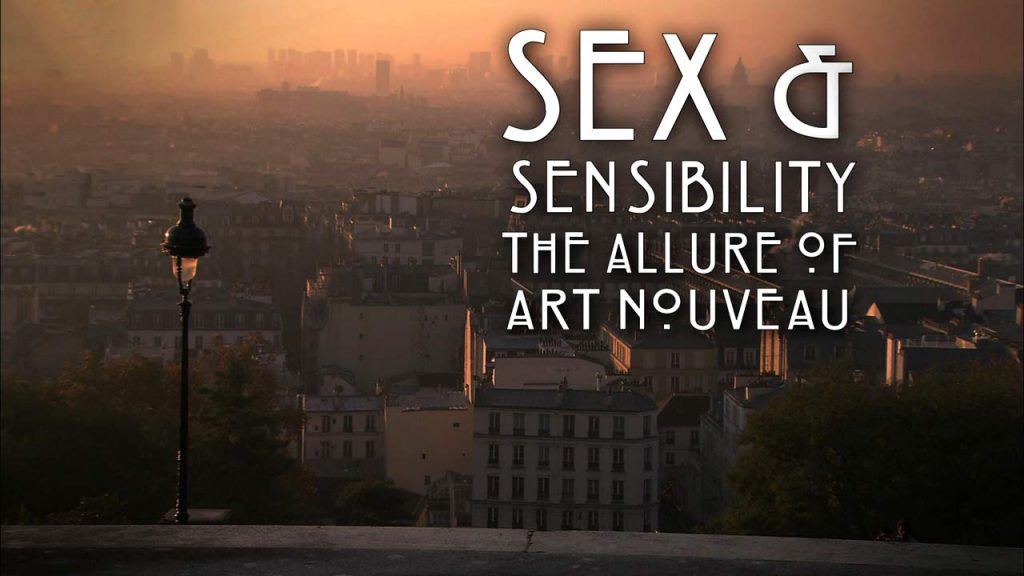The Allure of Art Nouveau episode 1 – Paris: The delicious objects of Parisian Art Nouveau are explored by cultural correspondent Stephen Smith. Stephen Smith explores the objects of Parisian Art Nouveau and learns how some of the 19th century’s most glamorous, controversial figures inspired an extraordinary movement.
Uncovering how the luscious decorative style first erupted into the cityscape, Stephen delves into the city’s bohemian past to learn how some of the 19th century’s most glamorous and controversial figures inspired this extraordinary movement. Revealing the story behind Alphonse Mucha’s sensual posters of actress Sarah Bernhardt, looking at the exquisite jewellery designer Renee Lalique and visiting iconic art nouveau locations such the famous Maxim’s restaurant, the programme builds a picture of fin-de-siecle Paris.
But Smith also reveals that the style is more than just veneer deep. Looking further into the work of glassmaker Emile Galle and architect Hector Guimard, he sees how some of art nouveau’s stars risked their reputation to give meaning and purpose to work they thought could affect social change.
The Allure of Art Nouveau episode 1 – Paris
Fin de siècle is a French term meaning “end of century”, a term which typically encompasses both the meaning of the similar English idiom turn of the century and also makes reference to the closing of one era and onset of another. The term is typically used to refer to the end of the 19th century. This period was widely thought to be a period of social degeneracy, but at the same time a period of hope for a new beginning. The “spirit” of fin de siècle often refers to the cultural hallmarks that were recognized as prominent in the 1880s and 1890s, including ennui, cynicism, pessimism, and “…a widespread belief that civilization leads to decadence.”
The term “fin de siècle” is commonly applied to French art and artists, as the traits of the culture first appeared there, but the movement affected many European countries. The term becomes applicable to the sentiments and traits associated with the culture, as opposed to focusing solely on the movement’s initial recognition in France. The ideas and concerns developed by fin de siècle artists provided the impetus for movements such as symbolism and modernism.
Art Nouveau
Art Nouveau is an international style of art, architecture, and applied art, especially the decorative arts, known in different languages by different names: Jugendstil in German, Stile Liberty in Italian, Modernisme català in Catalan, etc. In English it is also known as the Modern Style. The style was most popular between 1890 and 1910 during the Belle Époque period that ended with the start of World War I in 1914. It was a reaction against the academic art, eclecticism and historicism of 19th century architecture and decoration. It was often inspired by natural forms such as the sinuous curves of plants and flowers. Other characteristics of Art Nouveau were a sense of dynamism and movement, often given by asymmetry or whiplash lines, and the use of modern materials, particularly iron, glass, ceramics and later concrete, to create unusual forms and larger open spaces.
One major objective of Art Nouveau was to break down the traditional distinction between fine arts (especially painting and sculpture) and applied arts. It was most widely used in interior design, graphic arts, furniture, glass art, textiles, ceramics, jewellery and metal work. The style responded to leading 19-century theoreticians, such as French architect Eugène-Emmanuel Viollet-le-Duc (1814–1879) and British art critic John Ruskin (1819–1900). In Britain, it was influenced by William Morris and the Arts and Crafts movement. German architects and designers sought a spiritually uplifting Gesamtkunstwerk (“total work of art”) that would unify the architecture, furnishings, and art in the interior in a common style, to uplift and inspire the residents.
